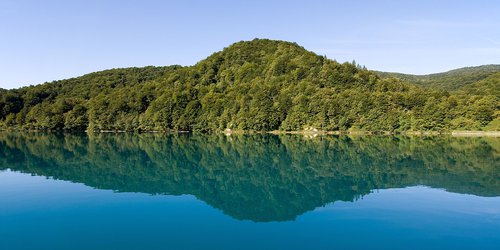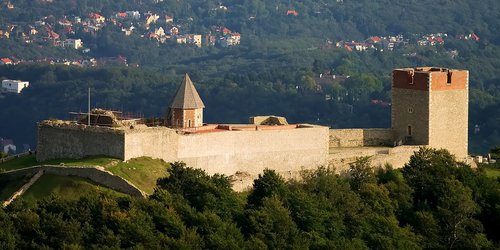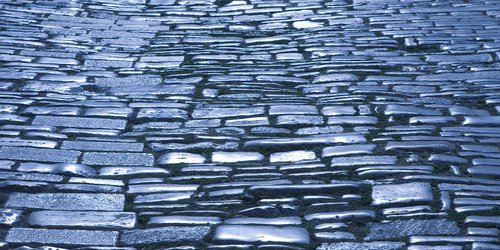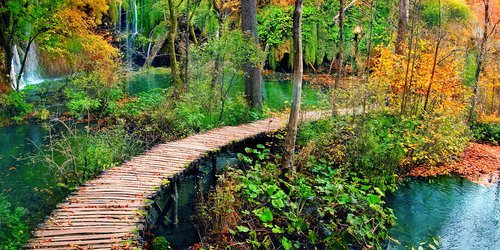Discover how the neighboring countries helped shape Croatia
Croatia is a small country extremely rich in history. Since the seventh century, when Croats are supposed to have arrived to this territory, countless armies have marched through it, antique empires built their strongholds in it, but we stubbornly kept claiming what we considered ours. The cultural diversity of all these centuries has become an integral part of our identity.
Vienna
Vienna carries its title of a "royal city" proudly. Located on the banks of the river Danube, its population accounts for one fifth of the population of Austria, and its symbol is St. Stephen's Cathedral. The city with a history that spans over a millenia abounds in important monuments, especially in the old city core where you can find the famous Schönbrun Palace, Hofburg Palace, Belvedere Palace and the Vienna State Opera, to name but a few. The influence Vienna has had on Croatia needs no special elaboration; visitors like to describe our Zagreb as a "little Vienna", and it is quite clear why: from the Austro-Hungarian architecture in the old city core, the beautiful green oases, all the way to the customary "bok" (Mein Buecken!) on the street – they are obviously a part of the same cultural heritage.
Venice
The Italian city of Venice, situated on the Adriatic Sea, is inextricably tied to Croatian history. Today Venice is a tireless generator of income for Italian tourism, but it is also a cultural center that everyone should see at least once in their lives. Once the center of the Republic of Venice, a large part of the city of canals and gondolas lies on a foundation of Croatian oak which comes from the base of the Velebit mountain. The cultural influence of Venice goes back six centuries, making it more clear why Mediterranean cuisine is still so dominant in Dalmatia, as are Italian expressions in everyday speech, and as is the "southern temperament" when it comes to the local population...
Bosnia and Herzegovina
Until recently the Hollywood token of a war zone, Bosnia and Herzegovina is slowly building a reputation as an undiscovered gem, and the strong Oriental influence on its culture has certainly affected the sharp rise of visitors to the country. According to a research conducted by the World Economic Forum, Bosnia and Herzegovina was voted the eighth friendliest country in the world. Sarajevo is definitely the primary destination for tourists. The city is rich in culture and history, and it hosted the Winter Olympic Games in 1984. Those familiar with it will know where to go: Baščaršija, where you will find the best ćevapi (national specialty, grilled minced meat) in the region! The second-most popular destination is Mostar, whose beautiful medieval bazaar has been fully preserved and is now protected as a part of the UNESCO World Heritage List.
Jewish Heritage
Jews are an ethnic and religious minority in Croatia whose roots in the area go back to Antiquity and the Middle Ages. Throughout Croatian history Jews have contributed significantly to the development not only of the country's economy and civil society, but also culture and science. In Solin there is a Jewish cemetery that dates back to the 3rd century. In the Middle Ages, European Jews would often seek refuge from prosecution in Croatia. That is why the majority of the Jews in the area today come from Spanish, Italian, Portuguese and CzechJews. Although a large number of synagogues were destroyed in World War II, some like the one in Rijeka still stand proudly. Numerous Jews have provided great contributions to Croatian culture, including the music conductor Antun Schwarz, and historical figures such as Vid Morpurgo, Josip Frank, Andrija Hebrang and Slobodan Lang.
The Ottoman Empire
At its peak in the 17th century, the Ottoman Empire occupied a large part of modern-day Croatia. That explains its strong influence in these parts, and especially in the Dalmatian hinterland and the east part of the country. In addition to the influence on the cuisine and alimentary habits, the dialects in those parts are rich in Turkish borrowings, and numerous names are in fact Turkish version of Croatian names. The architecture was in many places affected by the threat of the Ottoman Empire, resulting in a multitude of fortresses in the coastal areas built in defense from Ottoman incursions. This explains the name of Kaštela (Fortresses), an agglomeration of seven small towns located right next to the sea. The gastronomic heritageof theOttoman Empire is much sweeter, and it includes ćevapi, kebabs, sarma (dolma), yogurt, baklava, urmašice (hurma), and definitely the most precious: Turkish coffee.
Slovenia
Slovenia is a small, fairytale-like country with the Alps on the one end and the Adriatic Sea on the other. It is our first neighbor in more ways than one. Almost a century ago we began sharing membership in states that would change names and leaderships, and after the breakup of Yugoslavia we also became members of the European Union. Although we have not been "living together" for a quarter of a century now, we still love to visit Slovenia, and especially Ljubljana. Ljubljana is often compared to Prague due to its rich cultural heritage, and Croatian tourists gladly spend their winter holidays on the Slovenian skiing resorts in Vogel, Rogla and Kranjska Gora. Others prefer the numerous thermal baths for more relaxing holidays. It is no wonder we feel so relaxed there: we're at home!
Montenegro
Our small southern neighbor is significantly smaller than the neighboring Slovenia. The country has a population of only 600,000, but there are numerous attractions on the 300-kilometer-long coast. Ulcinj alone has a 20-kilometer-long beach. In addition to the geographical location, there is something much stronger that ties us to Monte Negro: Croats of Boka Kotorska, the southernmost Croatian tribe. The town of Boka is located south of Dubrovnik, and it was annexed by Monte Negro in 1945. Still in the 18th century these Croats had over 300 ships and were trading rivals to Dubrovnik and Venice. The beautiful country with a rich military history and cultural heritage is a natural and ever more popular continuation of an adventure in the south of Croatia.
Budapest
Throughout the centuries, the capital city of Hungary has had a great influence on the development of modern-day Croatia. Today a popular tourist destination, Budapest was for a long time the second seat of the Austro-Hungarian Empire, and it became a single city through the unification of Buda and Pest on the opposite banks of the river Danube. The city is rich in cultural monuments under the protection of UNESCO, such as the Buda Castle, Hősök tere, and the oldest European underground railway, while the Hungarian Parliament Building was built from the stone in Bihać. Hungary has played a significant role in the cultural shaping of continental Croatia, starting with the founding of the Zagreb Diocese in 1094. The oldest liturgical codices in Croatia also came from Hungary, but then we also should not forget the more worldly influences, such as the recipes for the best fish stews!
See also

Adventure to Remember
The diversity of Croatia has always delighted visitors and the same can be said of its tourist offers. Still, some of her jewels remain hidden even today, quite undeservedly so. Scattered all over the country, they are worth every minute and every effort spent in discovering them.

Green and Blue
One thing rarely crosses our minds when picking a vacation destination and yet we do think of it quite often while decorating our homes – the importance and influence of colors. Blue does not do for the living room or study, calming though it is, since it induces depression and exudes cold. On the other hand, green is the current queen of interior design: it relaxes the body, diminishes stress and improves vision. However important our living environment may be, the best way to get exposed to colors is in nature. Because nothing calms the soul like a body in movement surrounded by the beautiful shades nature creates

Islands and Half-islands
Every coast is charming in its own way, but once you experience the beautiful blue Adriatic, you will never want to leave! Small islands, interesting peninsulas, uninhabited isles and heart shaped islets, hidden coves and even more hidden vineyards in stunning bays will thrill you almost as much as the fantastic people who have chosen to build their lives in this at times cruel but always breathtaking beauty, far away from the mainland.

Knights and Legends
Croatia is most often referred to as the country with a thousand islands, but in this small country for a big vacation, there are over a thousand castles, palaces and forts as well. Some are home to museums, some to hotels, and in some people still live, be they in private hands or just happen to have towns grown around them.

Old Paths
Wherever you might find yourself in Croatia, you are likely to stumble upon fragments of history: Zagorje and Slavonija are full of burgs, forts, castles, but also prehistoric archaeological sites, while Dalmatia and Istria are brimming with traces of antiquity, Byzantium, medieval times and the Renaissance carved into stone. Tribes, nations and rulers have succeeded each other with a higher frequency than anywhere else, as can be seen in the recent turbulent history of the region.

Small Towns
The "small country for a big vacation" is filled with picturesque and unusual little towns in which big things happen! Each one has its own story and personality that makes it worth taking the time to both find it and find out all about it.

UNESCO Heritage
Every country has its charms, but some places are truly special; whether they are the result of natural processes, remains of ancient civilizations, or cities with ancient histories that still overflow with life. The United Nations Educational, Scientific and Cultural Organization, better known as UNESCO, has formed a World Heritage List of sites that serves to protect these magnificent localities, whether they belong to natural or cultural heritage, or sometimes both. In Croatia, seven sites have been inscribed on the List in the last 36 years, while 15 more have been nominated.

When in Croatia, Go Local!
When in Rome, do as the Romans do, goes the ancient proverb. It is the best advice any traveler ever got. Go local and do everything locals do in order to live the country you are visiting!